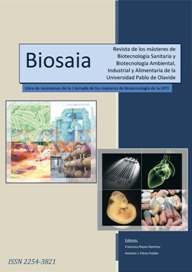Bioremediation of a polycyclic aromatic hydrocarbons contaminated soil using an indigenous consortium
Palabras clave:
Soil, Polycyclic aromatic hydrocarbons, microbial degrading consortium, biodegradation, mineralisationResumen
Polycyclic aromatic hydrocarbons (PAHs) include a group of organic priority pollutants of critical environmental and public health concern due to their toxic, genotoxic, mutagenic and carcinogenic properties. PAHs have been accumulated in the environment as a result of human activities. Bioremediation has become the most viable mechanism to reach the detoxification of contaminated sites. The objective of this study was to assess the capacity of an indigenous consortium enriched from an aged contaminated soil to biodegrade 16 PAHs, more concretely it was searched the complete removal of phenanthrene to CO2 and water.
A PAHs degrading microbial consortium (OMC), isolated from a contaminated soil, was investigated for 16 PAHs biodegradation activity. The OMC consortium was able to biodegrade six of the 16 PAHs studied, reaching 100% for naphtalene acenaphthylene, acenaphthene, fluorine, phenanthrene, naphthalene, acenaphthylene, acenaphthene, anthracene and fluoranthene. However, 78.4 and 53.86 % were removed for anthracene and fluerenthrene respectively.
Nine Strains were isolated from the OMC (PHE1,2,3,4,5,6,7,8,9). Isolated strains were tested to mineralise and in all cases the PHE concentration was drastically reduced. Once has been confirmed that indigenous bacteria were capable of degrading PAH and mineralising PHE were identified through 16S rDNA. Moreover, was proved the presence of genes including monooxygenase and dioxygenase by PCR amplification in the OMC and in the identified strains from the consortium. In OMC two of these genes were found: PAH RHDα GN and nahAC. However, in the isolated strains only one of the genes searched was identified: PAH RHDα GN, more specifically in Phe 8, Phe 4 and Phe 9.
As result, it is shown that bacteria from a contaminated soil are active in biodegradation and mineralisation process, what makes the indigenous microbiota a powerful tool for bioremediation uses.





